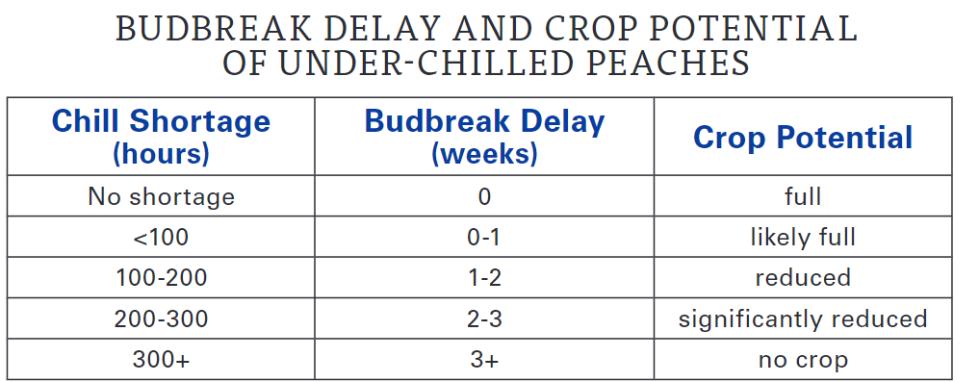What You Need To Know About Hydrogen Cyanamide and Budbreak in Peaches
Hydrogen cyanamide (CH2N2) is a registered active but toxic ingredient in products such as Dormex (AlzChem), BudPro (Green Trees, Plants II), and Krop-Max (Zhejiang Tide CropScience). Each of the products is labeled to stimulate uniform budbreak in some deciduous fruit and nut crops.
In general, hydrogen cyanamide can 1) overcome bud endodormancy and stimulate earlier uniform budbreak; or 2) compensate unfulfilled chill and induce budbreak delayed by chilling inadequacy. This focus is on peaches, but the information is relevant to other chill-dependent crops.
Hydrogen cyanamide, when applied prior to chilling satisfaction, may advance the peach harvest time by 10 to 14 days. It also may cause phytotoxicity and sometimes yield reduction. Little information is reported on whether and how the application impacts peach tree growth and yield in the following years.
Abnormalities in Under-Chilled Peaches
Warm winters have occurred more often over the past decades, resulting in more incidences of chilling inadequacy. For example, a new record of 520 chill hours was set in the winter of 2016-2017 in Byron, GA. Most high-chill peach cultivars (850-plus hours) appeared dormant in mid-April in central Georgia, where budbreak of such cultivars usually occurs early to mid-March.

In general, under-chilled peaches exhibit budbreak delay, crop loss, and other abnormalities, correlating with hours of chill shortage.
In general, under-chilled peaches exhibit budbreak delay, crop loss, and other abnormalities, correlating with hours of chill shortage. Generally, more hours of chill shortage delays budbreak longer and reduces yield more likely. If shortage is 300-plus hours, foliate budbreak delays several weeks and flower buds abort and quickly desiccate and abscise, leading to little bloom and no fruit set. In addition, rootstock suckers and adventitious budbreak are often seen on severely under-chilled peach trees.
Effects of Hydrogen Cyanamide
Hydrogen cyanamide advanced foliate lateral budbreak on severely under-chilled peaches about two weeks earlier than the controls in an experiment in 2017. But it had little effect on terminal and floral budbreak. Most terminal buds sprouted prior to the treatment, and most floral buds never opened but desiccated and abscised before they swelled. Phytotoxicity was also observed. However, between the sprayed trees and controls, there was no significant difference in the number and average length of the new lateral shoots by the end of 2017, nor in the number and weight of the fruit harvested in 2018. The results suggested that spraying dormancy-breaking products on severely under-chilled peaches had no benefit to tree growth in the applied year and yield in the coming year, although it stimulated early budbreak. In other words, if chilling inadequacy results in little or unprofitable crop, hydrogen cyanamide application appears unnecessary.
Concentrations, Spray Timing
It is crucial to follow the labels to apply hydrogen cyanamide products at appropriate concentration and timing to stimulate budbreak effectively while minimizing phytotoxicity. A comparison of 0.125, 0.25, 0.5, and 1.0 mole per liter (M) hydrogen cyanamide applied to adequately chilled peaches suggests 0.125 M stimulates budbreak most effectively while resulting in lowest phytotoxicity.
Applied to under-chilled peaches, hydrogen cyanamide effectively induces vegetative budbreak in a linear manner at the concentrations from 0% to 2%. The 2% rate appears most effective and phytotoxicity is limited. Timing is associated with the stage of bud dormancy. Apparently only sprays prior to chilling satisfaction promote the highest budbreak. Sprays after chilling satisfaction result in little effect on stimulating budbreak but likely cause high phytotoxicity on buds.
In summary, hydrogen cyanamide can stimulate early budbreak only when applied to peaches prior to chilling satisfaction or with inadequate chilling. Whether to apply hydrogen cyanamide on peaches also is an economic consideration; there is no need to apply hydrogen cyanamide if we don’t expect extra profit from advanced harvest or profitable yield from under-chilled trees, thus saving on-farm costs and eliminating unwarranted environmental impacts of this toxic chemical.









